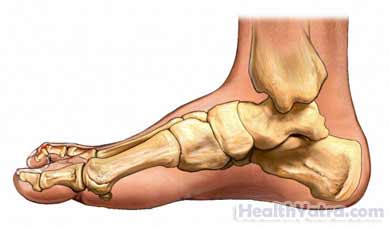Definition
Hammer toe occurs when there is a shortening of the tendon that controls toe movement. This causes the middle joint of the toe to be bent upward and the outer joint downwards. The misshapen toe resembles a hammer. A hammer toe correction is done to correct a toe deformity called a hammer toe.

Reasons for Procedure
A hammertoe correction is considered when:
- Other treatments have failed to bring about results.
- The affected toe has assumed an awkward position and is causing pain.
- The deformity makes walking difficult.
- The position of the toe causes breakdown of skin. This can increase the risk of developing a bone infection.
Possible Complications
Complications are rare, but no procedure is completely free of risk. If you are planning to have the correction, your doctor will review a list of possible complications, which may include:
- Infection
- Bleeding
- Excessive swelling, although the toe will normally be swollen for 4-8 weeks following surgery
- Anesthesia-related problems
- Recurrence of hammer toe
- Nerve or blood vessel injury to the toe
Factors that may increase the risk of complications include:
- Smoking
- Diabetes
- Bleeding disorders
- Poor circulation
What to Expect
Prior to Procedure
Your doctor will likely do the following:
- Physical exam
- X-rays
Talk to your doctor about your medicines. You may be asked to stop taking some medicines up to one week before the procedure, like:
- Aspirin or other anti-inflammatory drugs
- Blood thinners
The day of the procedure:
- Arrange for a ride to and from the procedure.
- Arrange for help at home after the procedure.
- Wear comfortable clothing that is easy to remove.
Anesthesia
Local anesthesia is often used. It will numb the area. Spinal anesthesia may also be used. This anesthesia will make your lower body numb.
Description of the Procedure
Several surgical options are available for hammer toe correction. Some corrections can be made with changes to soft tissue. Others need to be made to the bone.
Soft Tissue
This is usually best in patients under 30, with limited toe deformity. A cut is made in the skin and the tendon is released. Sometimes it is reattached to a different area of the bone. The changes in soft tissue will allow the toe to relax and eliminate the deformity.
Bone
Two common methods of hammer toe correction on the bones themselves are joint arthroplasty and joint fusion. The type of procedure used depends on the deformity. A combination of procedures may be needed. In both cases, a cut in the skin is made over the toe joint.
During an arthroplasty, part of the bones on both sides of the middle toe joint may be removed. This will allow the toe to uncurl.
During a fusion, the ends of the toe bones are removed. The bones are then repositioned. The repositioning is usually held together with a pin placed within the bone. The pin may be removed after 3-4 weeks. Other changes to the anatomy of the foot due to the hammer toe may also be corrected at this time.
The incision will be closed with stitches. Dressings will be applied to hold the toe in proper position.
How Long Will It Take?
This depends on the procedure and the number of toes corrected.
Will It Hurt?
Anesthesia prevents pain during the surgery. You will be given medicine to manage pain after the surgery.
Post-procedure Care
- During the first couple of days, keep your foot elevated most of the time.
- Limit standing and walking, and stay off your foot as much as possible.
- Use crutches or wear a special open-toed, wooden-soled shoe, as directed by your doctor .
- Ask your doctor about when it is safe to shower, bathe, or soak in water.
The corrected toe may be slightly longer or shorter than before surgery. The toe will not move as much as a normal toe. Expect some swelling and redness, which may last for several months. Your dressing may need to be adjusted as swelling decreases. If it appears that the deformity may recur, your doctor may choose to continue with dressings for another 2-4 weeks.
Select shoes with plenty of space for your toes. Poorly fitting shoes contribute to hammer toe development.
Call Your Doctor
After arriving home, contact your doctor if any of the following occurs:
- Signs of infection, including fever and chills
- Redness, swelling, increasing pain, excessive bleeding, or any discharge from the incision site
- Pain that you cannot control with the medicines you have been given
In case of an emergency, call for medical help right away.
